The right respirator can protect your lungs from lye mist as well as from toxic or irritating dusts such as colorants (micas, oxides, etc.), powdered surfactants (SLS, SLSA, etc.), bath-bomb ingredients (citric acid, baking soda), and other ingredients used in bath-and-body (B&B) products.
The right respirator can also protect your lungs from volatile chemicals, such as essential oils (EOs) and fragrance oils (FOs), that can cause irritation or cause allergic reactions if inhaled.
Here is my guide for choosing the right respirator for your needs.
Respirator for lye mist and other hazardous or irritating dusts and mists
If you want a respirator for short exposure to lye mist and for protection from hazardous or irritating dusts, I would choose a high efficiency particulate respirator with an "N100" or "P100" rating. (1) This type of respirator removes 99.97% of the dust and mist in the air (2), assuming the respirator is fitted properly to your face.
There are respirators with less stringent "N95" ratings with a 95% removal efficiency. An N95 respirator is not much cheaper than an N100 or P100 respirator, so I recommend getting the highest level of protection for your money.
You can get high efficiency respirators in two basic styles --
The first basic style is the disposable respirator. It will look like a cup of soft white felt or fabric that fits over the mouth and nose. It must have at least two sturdy, adjustable elastic bands to mold the mask firmly to the face. 3M's disposable 8233 respirator is N100 or P100 rated and costs under $10 USD. Discard a disposable respirator when it gets dirty or hard to breathe through, whichever comes first.
 (4)
(4)
The second basic style is a "half face" respirator that comes in two parts -- a reusable facepiece and replaceable cartridges. Facepieces come in sizes; many women will want the small facepiece. 3M makes a variety of facepieces that can be fitted with different types of cartridges. 3M's reusable 6191 facepiece fitted with N100 or P100 cartridges costs under $20. I replace particulate cartridges when they get hard to breathe through or when they look dirty, whichever comes first.
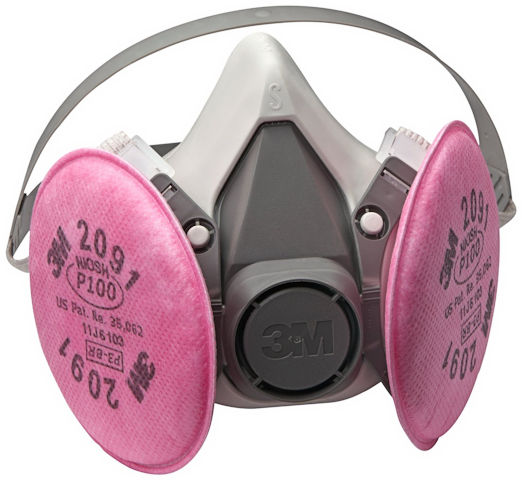 (4)
(4)
There are other reputable manufacturers to choose from -- just look for a respirator with the N100 or P100 rating and, in the USA, a NIOSH, OSHA, or MSA approval stamp or statement.
Many stores sell a "nuisance dust" respirator with a single, thin, non-adjustable elastic band to hold it onto the face. Frankly, you're better off holding your breath rather than trusting your lungs to this type of respirator.
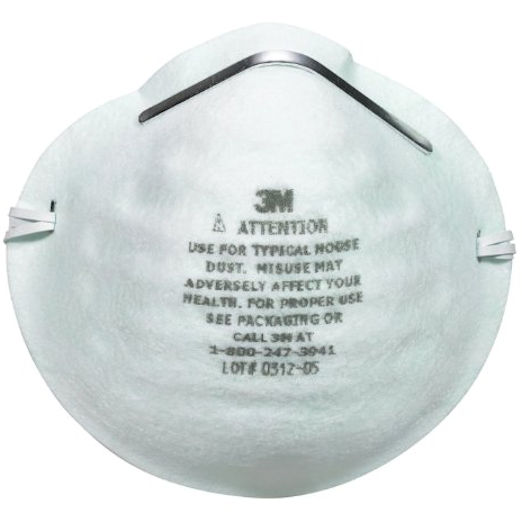 (4)
(4)
Respirator for volatile chemicals
If you also want protection against inhaling volatile organic chemicals (2) such as FOs and EOs as well as lye mist and toxic or irritating dusts, then you will need a respirator rated for organic vapors and for N100 or P100 particulate removal.
This kind of respirator doesn't come in a disposable style; you have to use a reusable facepiece such as 3M's 6191 facepiece and install the correct cartridges on the face piece.
What kind of cartridges should you use for volatile organic chemicals?
If you don't have serious health issues with EOs or FOs and don't work with them a lot, you could use N100 or P100 particulate cartridges with the added ability to remove small amounts of "nuisance organic vapors." 3M's 2097 cartridges are rated for N100 or P100 particulates and for nuisance organic vapors.
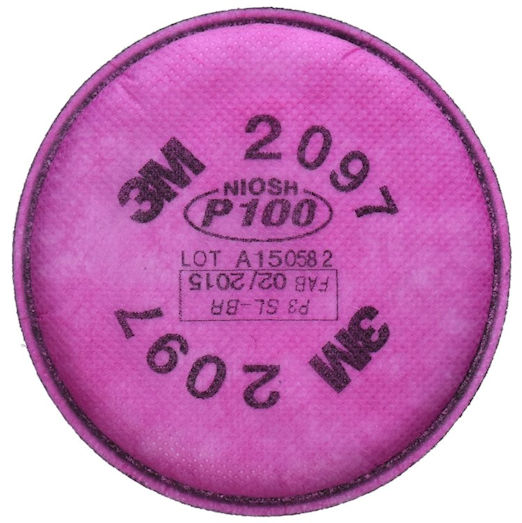 (4)
(4)
If you do have respiratory health issues, are sensitive or allergic to EOs or FOs, or are working with EOs and FOs a lot, you should consider using full-fledged heavy-duty organic vapor cartridges. 3M's 60921 cartridges remove organic vapors AND are N100 rated for particulates.
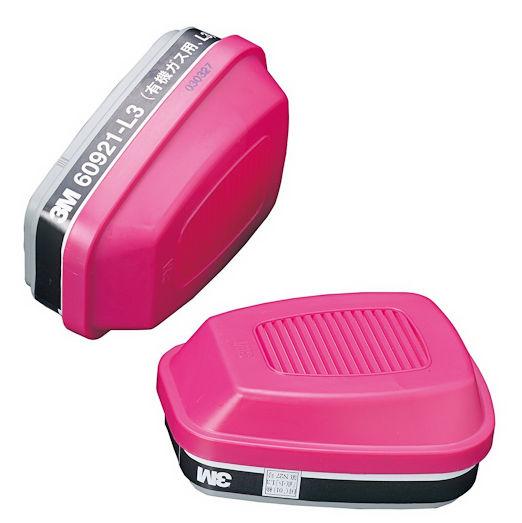 (4)
(4)
Again, there are other reputable manufacturers to choose from -- just look for respirator cartridges that are rated for removing organic vapors. In the USA, the cartridge should carry a NIOSH, OSHA, or MSA approval stamp or statement.
If at any time you can smell the odor of the FOs or EOs when wearing an organic vapor respirator, first check the fit of the respirator (see below) to eliminate any leaks. If you can still smell the odor, then the cartridges are spent and you should replace them immediately.
Fitting a respirator
Get the right size for your face. If the respirator doesn't seal well to your face without leaking, it can't do its job. A person might as well not wear a respirator at all if it doesn't fit right or isn't the right kind of respirator for the job.
If you're buying a respirator at a "big box" hardware or lumber store, the respirator selection is likely to be geared toward men. That means the disposable respirators and reusable facepieces are probably going to be mostly (or all) in the medium and large sizes. Many women need a small size mask to fit smaller cheekbones and narrower jaw, so if you are a gal, you may need to order from a catalog or online (see the links in this article.)
Disposable respirators. A disposable respirator is more difficult to fit properly, so if you have a hard-to-fit face like me, you may not be able to use a disposable respirator.
There should be two bands on a disposable respirator -- one to go around the back of your head to stabilize the top part of the mask and one around the back of your neck to stabilize the lower part. Tighten each band so the mask is pulled gently against your face. Don't overtighten to avoid distorting the fit and causing headaches.
After snugging the mask onto your face, pay close attention to bending the metal that goes over your nose, so that area of the respirator fits snugly over the bridge of your nose and along your upper cheeks.
When the mask is adjusted to fit comfortably, take a deep sharp breath in and pay attention to the sensation of any cool air flowing in around the edges of the mask. A properly fitted disposable should "suck down" tight against the face when you take a deep breath in, and all of the air should be coming through the mask material.
The top of the nose and the jaw bone are the usual trouble spots for me. If you feel leaks, adjust the mask as needed to improve the seal.
If you can't get the mask to stop leaking no matter what you do, you may need to try a different size and/or a different style. Or you may need to switch to a reusable facepiece.
Reusable respirator. Fitting a resuable respirator is basically the same -- your goal is to have no leaks around the edges of the facepiece when you suck in a deep breath. The facepiece of a reusable respirator has large, soft rubbery gaskets that mold better to your face, so getting a good seal is often easier than with a disposable.
To adjust the fit for a good seal, first remove the cartridges from the facepiece. To remove a cartridge, twist it a quarter or half a turn and pull it away from the facepiece. Put the facepiece on and adjust the elastic bands to give a snug, but comfortable fit around your face.
Put the palms of your hands over the holes where the cartridges normally go to seal those openings. Take a sharp breath in. Because you're sealing off the air intake, the facepiece should seal tightly to your face, letting no air in. If you feel leaks, adjust the fit as needed.
If you have leaks that you just cannot get rid of no matter what you try, you might need a different size facepiece to get a better fit.
You can find more advice about using respirators and other protective gear in the Safety Training section at Gemplers. (3)
Beards. If you have a beard or mustache, be aware that almost all disposables and most reusable "half face" facepieces can't handle facial fuzz. You may need to go the next step up to a "full face" respirator such as 3M's 6700 respirator for proper fit and effective protection.
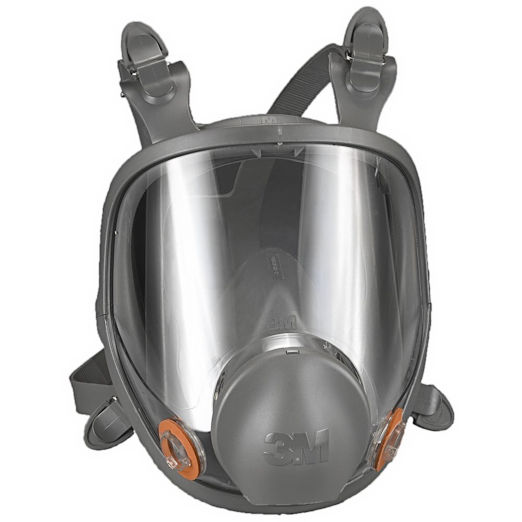 (4)
(4)
The bottom line
If you're going to wear a respirator for making soap or other bath-and-body products, then choose it and use it wisely. Wearing an ineffective, poorly fitting respirator or a cheap "nuisance dust" mask can give a person a false sense of protection.
Respirators are not the only solution nor are they always the best solution for controlling your exposure to dusts, mists, and volatile chemicals.
It is a much better approach to first reduce how much of these pollutants get into the air in your home or workshop and then use a respirator as insurance.
Ways to reduce air pollution in your home or workshop when soaping or making B&B products --
Work with lye, fragrances, and dusty ingredients outdoors in good weather
Using effective ventilation in your work area (such as a running stove hood that vents outdoors)
Keeping your lye container lightly covered at all times, but especially while the solution is hot
Wearing an effective respirator as a final bit of insurance
Notes and references
1. What does the "N100" or "P100" rating mean?
The "100" refers to the respirator's ability to remove small particles of solids (dusts) or small droplets of liquids (mists). A respirator with a 100 rating is 99.97% efficient at removing dusts and mists. One with a "95" rating is 95% efficient.
The "N" means the type of materials the respirator is designed to handle. A respirator with an "N" rating is not rated for use where there are oily dusts or mists in the air. A respirator with a "P" rating is rated for oily dusts and mists. For making soap or other bath-and-body products, buy whichever type -- N or P -- that is cheapest or most easily available.
2. What is a dust, mist, or volatile chemical?
A dust is a cloud of very small solid particles. Powdered colorants for soap will create dust if blown into the air. The visible smoke from a cigarette a type of dust. Dusts can be so fine they are invisible to the eye; these super fine dusts are the most damaging to your lungs.
A mist is a cloud of fine liquid droplets. The steam you see rising from your coffee cup or from a beaker of hot lye solution is a mist. A cloud in the sky is another example of mist.
A volatile chemical evaporates into the air to form a gas. Perfume, essential oils, fragrance oils are volatile chemicals. Humidity (water vapor) in the air is a volatile chemical. A respirator that is designed only for dusts or mists cannot remove volatile chemicals.
3. Gemplers. Safety Training Sheets. https://gemplers.com/pages/safety-training
4. All images courtesy of 3M. https://www.3m.com/3M/en_US/p/c/ppe/
Copyright © 2002-2025 - All rights reserved by Classic Bells Ltd.
Template by OS-templates.com